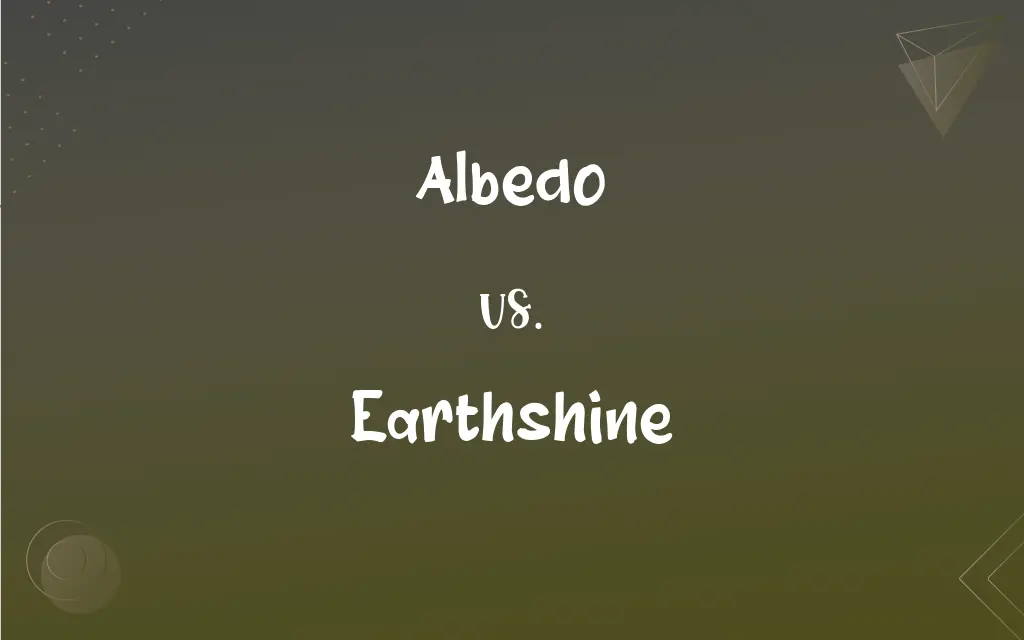Albedo vs. Earthshine: What's the Difference?
By Harlon Moss || Updated on May 22, 2024
Albedo is the measure of reflectivity of a surface, while earthshine is the sunlight reflected from the Earth that illuminates the moon.

Key Differences
Albedo refers to the fraction of sunlight that a surface reflects back into space. Surfaces with high albedo, like ice and snow, reflect most of the sunlight, whereas darker surfaces like forests and oceans have lower albedo. Earthshine, on the other hand, is the phenomenon where sunlight reflects off the Earth's surface and illuminates the dark part of the Moon. This is most visible during a crescent moon phase. Earthshine provides indirect illumination to the Moon, making the unlit portion faintly visible.
The concept of albedo is used in climatology and astronomy to understand how different surfaces on Earth and other celestial bodies influence temperature and energy balance. It is a critical factor in global climate models. Earthshine helps astronomers study Earth's reflectivity from space, providing insights into the planet's surface and atmospheric properties.
Albedo can be measured for any planetary body, including Earth, the Moon, and other planets. For instance, Venus has a high albedo due to its thick cloud cover. Earthshine, however, is specific to the Earth-Moon system, as it describes the particular reflection of sunlight from Earth to the Moon.
Albedo values range from 0 to 1, with 0 meaning no reflection and 1 indicating total reflection. Earth's average albedo is around 0.3, meaning 30% of the incoming solar radiation is reflected. Earthshine varies in intensity depending on Earth's surface and atmospheric conditions and the lunar phase.
Comparison Chart
Definition
Measure of reflectivity of a surface
Sunlight reflected from Earth illuminating the Moon
ADVERTISEMENT
Range
0 (no reflection) to 1 (total reflection)
Varies with Earth's surface and lunar phase
Application
Climatology, astronomy, planetary science
Observational astronomy, studying Earth’s reflectivity
Measurement
Quantified for any celestial body
Specific to Earth-Moon system
Influence
Affects Earth's climate and energy balance
Provides insight into Earth's surface and atmosphere
Albedo and Earthshine Definitions
Albedo
Reflectivity of a surface.
Snow has a high albedo, reflecting most sunlight.
ADVERTISEMENT
Earthshine
Provides data on Earth's reflectivity.
Astronomers use earthshine to study Earth's atmosphere.
Albedo
Measure used in climate studies.
Scientists study albedo to understand global warming.
Earthshine
Sunlight reflected from Earth to the Moon.
Earthshine makes the dark part of the crescent moon visible.
Albedo
Relevant in planetary science.
Venus’s clouds contribute to its high albedo.
Earthshine
Observed during specific lunar phases.
You can see earthshine during a crescent moon.
Albedo
Expressed as a fraction.
Earth's average albedo is about 0.3.
Earthshine
Unique to Earth-Moon interaction.
Earthshine is a beautiful demonstration of Earth’s albedo.
Albedo
The fraction of incident electromagnetic radiation reflected by a surface, especially of a celestial body.
Earthshine
Variable intensity.
Earthshine is brighter when Earth’s surface is more reflective.
Albedo
The spongy white tissue on the inside of the rind of citrus fruit.
Earthshine
The sunlight reflected from the earth's surface that illuminates part of the moon not directly lighted by the sun. Also called earthlight.
Albedo
The fraction of incident light or radiation reflected by a surface or body, commonly expressed as a percentage.
Earthshine
(astronomy) Reflected earthlight visible on the Moon's night side.
Albedo
(botany) The whitish inner portion of the rind of citrus fruits that is a source of pectin, commonly referred to as the pith.
Albedo
(alchemy) One of the four major stages of the magnum opus, involving purification of the prima materia.
Albedo
Whiteness.
Albedo
The ratio of reflected to incident light
Albedo
Property affecting energy balance.
A higher albedo means less heat is absorbed by the planet.
FAQs
Why is albedo important in climate studies?
Albedo affects the Earth's energy balance and climate by determining the amount of solar energy absorbed or reflected.
How is albedo measured?
Albedo is measured on a scale from 0 to 1, where 0 means no reflection and 1 means total reflection.
What is albedo?
Albedo is the measure of reflectivity of a surface, indicating how much sunlight is reflected back into space.
What affects albedo on Earth?
Albedo is influenced by surface properties like ice, snow, forests, and oceans, and their respective colors and textures.
What does earthshine tell us?
Earthshine provides information about Earth's reflectivity and atmospheric conditions.
Does albedo apply only to Earth?
No, albedo can be measured for any planetary body, including moons, planets, and asteroids.
How does albedo impact global warming?
Changes in albedo can influence the Earth's temperature, with higher albedo leading to cooling and lower albedo leading to warming.
What is earthshine?
Earthshine is the sunlight reflected from Earth that illuminates the dark portion of the Moon.
Can earthshine vary in brightness?
Yes, earthshine brightness varies depending on Earth's surface conditions and the lunar phase.
What is the average albedo of Earth?
Earth's average albedo is about 0.3, meaning it reflects 30% of the incoming solar radiation.
When can you see earthshine?
Earthshine is most visible during the crescent moon phase.
How does earthshine differ from moonlight?
Moonlight is sunlight reflected off the Moon's surface, while earthshine is sunlight reflected off Earth and then the Moon.
What creates earthshine?
Earthshine is created by sunlight reflecting off Earth's surface and illuminating the Moon.
Does albedo affect weather patterns?
Yes, surfaces with different albedos can affect local and global weather patterns by altering heat absorption and reflection.
What kind of surfaces have high albedo?
Surfaces like ice, snow, and deserts typically have high albedo.
How does earthshine contribute to our understanding of Earth's climate?
By studying earthshine, scientists can infer changes in Earth's reflectivity and surface conditions, aiding climate research.
How is earthshine useful to astronomers?
Astronomers use earthshine to study Earth's reflectivity and gain insights into its atmospheric properties.
Is albedo a constant value?
No, albedo can change with seasons, weather, and surface changes like ice melting or vegetation growth.
Is earthshine unique to the Earth-Moon system?
Yes, earthshine specifically describes the sunlight reflected from Earth to the Moon, making it unique to this system.
Can we see earthshine without telescopes?
Yes, earthshine is visible to the naked eye, especially during a crescent moon phase.
About Author
Written by
Harlon MossHarlon is a seasoned quality moderator and accomplished content writer for Difference Wiki. An alumnus of the prestigious University of California, he earned his degree in Computer Science. Leveraging his academic background, Harlon brings a meticulous and informed perspective to his work, ensuring content accuracy and excellence.































































